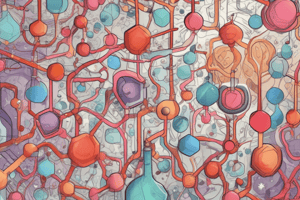Podcast
Questions and Answers
What is the primary purpose of determining the melting point of a compound?
What is the primary purpose of determining the melting point of a compound?
- To determine the boiling point of a compound
- To identify a substance and indicate its purity (correct)
- To determine the solubility of a compound
- To identify the molecular formula of a compound
What is the characteristic of a pure crystalline compound's melting point?
What is the characteristic of a pure crystalline compound's melting point?
- It has a wide range of temperature
- It has a high melting point
- It has a low melting point
- It melts completely over a narrow range of temperature (correct)
What happens to the melting point of a compound when impurities are present?
What happens to the melting point of a compound when impurities are present?
- The melting point increases and the range narrows
- The melting point decreases and the range widens (correct)
- The melting point remains the same
- The melting point increases
What can be estimated by comparing the melting point of a material with that of a pure sample?
What can be estimated by comparing the melting point of a material with that of a pure sample?
Which of the following is a factor that affects the melting point of a compound?
Which of the following is a factor that affects the melting point of a compound?
What can be concluded if two pure samples have the same melting point?
What can be concluded if two pure samples have the same melting point?
What is the effect of intermolecular forces on the melting point of a compound?
What is the effect of intermolecular forces on the melting point of a compound?
What is the characteristic of the melting point range of an impure substance?
What is the characteristic of the melting point range of an impure substance?
Which type of intermolecular interaction is responsible for the high melting point of butyric acid?
Which type of intermolecular interaction is responsible for the high melting point of butyric acid?
What is the primary purpose of the laboratory exercise described in the content?
What is the primary purpose of the laboratory exercise described in the content?
Which of the following compounds is expected to have the lowest melting point?
Which of the following compounds is expected to have the lowest melting point?
What is the purpose of sealing one end of the capillary tube in the capillary method of measuring melting point?
What is the purpose of sealing one end of the capillary tube in the capillary method of measuring melting point?
Why does sodium butanoate have a higher melting point than butyric acid?
Why does sodium butanoate have a higher melting point than butyric acid?
What is the role of the porous plate in the capillary method of measuring melting point?
What is the role of the porous plate in the capillary method of measuring melting point?
Which type of intermolecular interaction is responsible for the higher melting point of methyl propionate compared to butane?
Which type of intermolecular interaction is responsible for the higher melting point of methyl propionate compared to butane?
What is the advantage of using the capillary method to measure melting point?
What is the advantage of using the capillary method to measure melting point?
Flashcards are hidden until you start studying
Study Notes
Melting Point
- The melting point is a crucial physical property of a compound that can be used to identify a substance and indicate its purity.
- A pure crystalline compound typically has a sharp melting point and melts completely over a narrow temperature range of not more than 0.5-1°C.
- The presence of impurities can produce a depression in the freezing points and increase the width of the melting point range.
- A melting point range of > 5°C usually indicates that the substance is impure.
Factors Affecting Melting Point
- The size of the molecule affects the melting point, with smaller molecules typically having lower melting points.
- The force of attraction between molecules also impacts the melting point, with stronger intermolecular interactions resulting in higher melting points.
Examples of Melting Point
- Ethanol has a melting point of -114.1°C, while ethyl cellulose has a melting point of 151°C due to its larger molecular size.
- Isomers n-butanol and t-butanol have the same molecular formula but differ in their structure, and thus may have different melting points.
Intermolecular Interactions
- Ionic compounds typically have high melting points due to strong electrostatic forces.
- Organic compounds with polarity or hydrogen bonding tend to have higher melting points.
- Examples of intermolecular interactions include:
- Butane, which has a low melting point due to weak Van der Waals force of attraction.
- Methyl propionate, which has a higher melting point due to dipole-dipole interaction.
- Butyric acid, which has a higher melting point due to hydrogen bonding.
- Sodium butanoate, which has a higher melting point due to strong ionic interaction.
Determining Melting Point
- The most common method of determining melting point is the capillary method.
- The capillary method involves:
- Powdering the crystalline substance.
- Filling a capillary tube with the substance.
- Attaching the capillary tube to a thermometer.
- Heating the sample until it reaches melting point, then recording the melting point.
Aim of the Experiment
- The purpose of the laboratory exercise is to identify and assess the purity of an unknown solid organic compound by determining its melting point and comparing it to a list of possible compounds.
Studying That Suits You
Use AI to generate personalized quizzes and flashcards to suit your learning preferences.




